
|   |

|   |
November 1, 2015  Hello November from the crisp air of New York City. An intense week spent watching so much dance and theatre in my former home town that I have a sensorial overload. Contemporary ballet (Ballet Memphis) exploring many themes including Gospel music; the magical Misty Copeland (the first black prima ballerina with American Ballet Theatre); SANKAI JUKU in contemporary Butoh, modern dance (John Kinzel), Egyptian tombs, Picasso, Philippine Gold treasures (Asia Society), dancers with robots (Wendy Whelan) and brilliant contemporary music ensembles (Macarthur genius grantee Claire Chase). This is what the fabulous NYC offers on a daily basis to its residents and visitors. And, and, and....THIS is the annually perfect personal RESET AND REBOOT button for yours truly. However, the more interesting encounters have been with dance writers and dance passionistas. Robert Johnson and Elizabeth Zimmer shared their despair about the vanishing space for honest criticism (we have heard this before right?) and the impatience of today's American youth who don't care about dance. Newspaper surveys conducted in the NYC metropolitan area revealed that less than 2% of the readers care about dance. Meanwhile, there are more and more dance studios and rehearsal spaces opening up in the city. Dancers seem to be everywhere, stretching, flexing, moving… and yet… there is less and less money in the NYC area for independent artistes. New York dance audiences, however, are among the most sophisticated in the USA, guarded with their praise and watching with enthusiasm and not awe. Young dancers are eager to watch as much as they can (and can afford) and that is a welcome change from what I see in India. Major theatres have a policy $29 seats for those under 29 years of age. But what about those in their 30s? When tastes mature and bank accounts wither? Many Big Apple dance lovers are asking questions about how they can continue to support dance if the ticket prices soar each year. 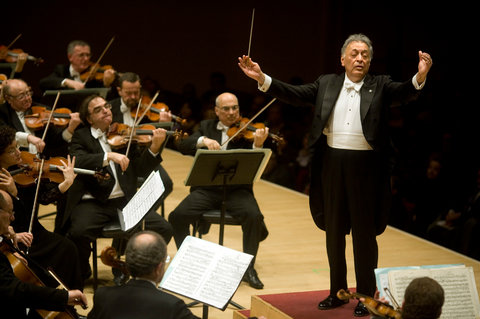 Zubin Mehta, Courtesy The New York Times No talk of tickets back home in Madras for the most coveted invitation of the year. The much anticipated Zubin Mehta concert, conducting the Australian Symphony Orchestra on their India tour. I have never been more popular as long lost acquaintances and friends called me for an invite. News of the Music Academy Hall being packed with kanjivaram silk saris and swishing pallus - walking sticks and wheelchairs galore! Zubin thrilled Madras and was reportedly delighted to be in the city whose music knowledge he deeply respects. Audience demographics make for interesting studies. Mehta crowds were older and noticeably the city's social elite. A marked change from the youthful electricity at Akram Khan's TOROBAKA tour last month. Having the opportunity to watch the performance in Chennai and Kolkata, I preferred the latter show solely due to the magical presence of B.C. Manjunath! Watching and listening to his impeccable polyrhythms for TOROBAKA was a performance in itself! At times playing unobtrusively in the dark, then stepping into the circular "bull ring" pool of light to dazzle uttering his "konnakkol" pneumonics with the flair and panache of an actor; suddenly breaking into Spanish counting with Uno, Dos, Tres, Quatro, Cinco for Flamenco soloist Israel Galvan - playing mridangam, ghatam, ganjira with aplomb and uttering the Kathak bols for Akram Khan's dizzying spins.. MANJUNATH IS SIMPLY WONDERFUL! Why have Chennai sabhas not featured him more often? What makes this brilliant talent, who has already collaborated with L. Subramaniam, George Maquona and now Akram Khan still relatively unknown to my city? Could it be that he is NOT TAMIL? Could our sabhas still be so parochial with musicians? Dancers will now be making a bee line for his door but may be tripped up with his phenomenal sense of 'laya' and world rhythms. TOROBAKA's six city India tour was prefaced by a huge amount of hoopla and PR but the fact remained that flamenco artiste Galvan Israel clearly outperformed Akram and that many were actually UNDERWHELMED by Khan's stage presence (in spite of his phenomenal dancing). Does this mean that Indian dancers are thinking and making up their own minds? Notwithstanding the standing ovations that have become so passé that Indians today will stand up and cheer for anything these days without discernment! 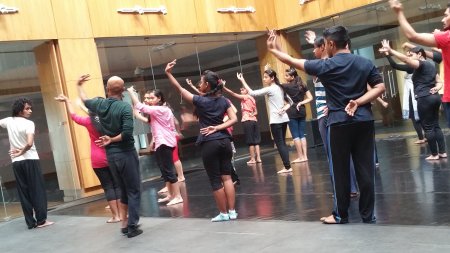 Akram in rehearsal Watching Akram at the spacious ICCR complex in Kolkata was another bonus experience. A personal engagement brought me to Durga's city on the same weekend that the British superstar was in town. Over 50 young dancers had registered for the two hour session which was organized by RHYTHMOSAIC (Ronnie and Mitul) in co-operation with British Council. Akram began with the rhythm of Kathak, specifically with a phrase from TOROBAKA. Breaking it down into beats, hand gestures, body stances and then moving in a total combination was not easy for the dancers to follow. Akram was on the move, dancing, teaching, coaxing, encouraging but never waiting for others to catch up. He also showed his amazing sense of FALLING flat on the floor... catching himself just before crashing into the hard surface. Borrowing a red lipstick, he drew a face onto his bald head, lowered it into his hands and started a "conversation". The dancers were entranced and each received a certificate and a group photo with their idol. Now, will we see that one phrase introduced into new routines in dance shows and competitions? If only dancers will not crowd around him asking to join his company, but instead, introspect about the art and their own place in the dance discourse! The level of questioning I heard at Kolkata was very basic and the New Delhi sessions were, it seems, even more disappointing. Akram's talks in some cities were highly appreciated and revealed his approach and clarity in collaborations. 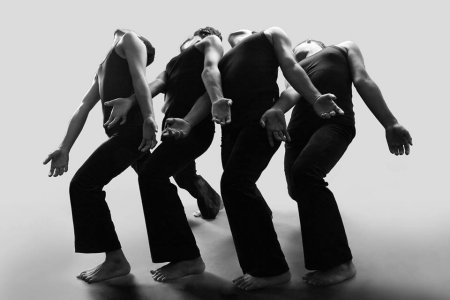 Rhythmosaic Each city introduces me to dancers and their dilemmas. In Kolkata, the dance map was once divided into the classical group vs the modern Shankars. Even within the first family of modern Indian dance, there were two factions – Amala / Mamta Shankar and Ananda / Tanushree Shankar... Now Kolkata has many contemporary dance groups - Ranan, Rhythmosaic, Sapphire - each with their own mantra and pathway. While the artistic directors are immersed in their individual creative arc, the landscape of contemporary dance in India remains relatively patchy. Sheer resilience has now forced dancers to choreograph for weddings, television shows and special events. Staging large group choreographies is also a good source of revenue. Makeup, costume and lighting design continue to lure some dancers towards livelihood issues. Corporate bookings for dance have come down with the crippling entertainment tax on all five star establishments and shows held within those plush premises. However, costs in Kolkata are the lowest of all Indian metros. Film and TV celebrities are only paid 1 to 2 lakhs for an appearance at a Durga Puja event. In other parts of India you have to add one or two zeros after the first number to even get celebs to get out of bed! 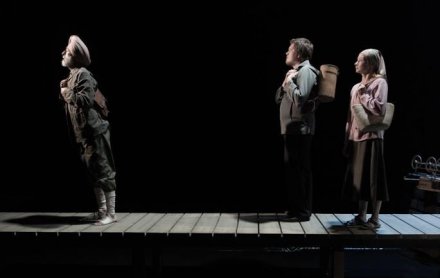 Navtej Johar in THE WATER STATION Courtesy: Exeunt magazine 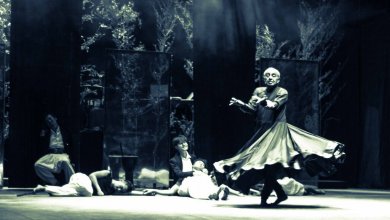 Astad Deboo in HAMLET 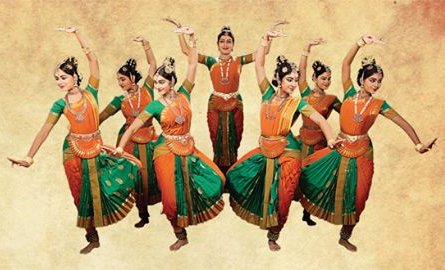 Anitha Guha's SUNDARA KANDAM Meanwhile, three dance productions have completed their successful tour of the US -- all created in Chennai. Anitha Guha's SUNDARA KANDAM has been a rousing success in their 16 city tour to benefit the late Swami Dayanand Saraswati's AIM FOR SEVA. Despite a lukewarm and less than perfect Chennai premiere this summer, the Spanish-Indian DON QUIXOTE has garnered mostly positive responses from many cities. While many walked out of the Chicago show and several comments were made about the duration of the show and childish attempt at humour, the show has been noticed for Sheejith Krishna's choreography And then, the juggernaut of the one and only "Phillum Ishtar" Shobana rolled through the US with her multimedia KRISHNA, leaving audiences stunned!!!!???? 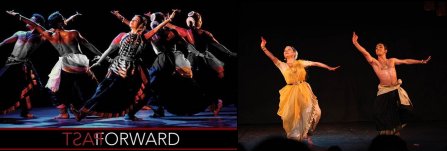
SPANDA's PAST FORWARD
Already in the US now are Leela Samson and her SPANDA company with new repertoire to celebrate their 20th anniversary. PAST FORWARD is the title of the tour (a twin word used very often as the title in dance conferences, theatre works and publications). FIRE AND ASH directed by Gowri Ramnarayan on Lord Shiva is making the rounds of museums and universities. All these shows are conceived and created in Chennai for audiences in the US of A. What would hundreds of our artistes do without the patronage of the US NRI community? Who will fund the new car, new addition to the home, new anything? (This applies much more to dance musicians than to dancers). It is really an undocumented global export that is on the rise, no matter what the stagnant economic index says. The UK, Europe and Australia do not support or patronize our dancers and musicians like the USA does. And so, despite our haste to denounce the NRI avalanche, we need to be grateful to those organizers and ticket buyers who continue to invite our performing artistes year after year. The only argument is that US NRI audiences are very old fashioned, preferring the neo classical disguised as "contemporary" and not really wanting much more than a good night out. Well... to each continent, their own! For Indian dancers based in the US, touring like the India based groups remains a distant dream, the sole exception being the grandly funded Ranee Ramaswamy's Ragamala Dance Company from Minnesota. A large grant from the Doris Duke Foundation and several other lucrative supporters has propelled this company into the national touring circuit in the USA. Daughter Aparna Ramaswamy completed a successful solo season at the JOYCE theatre in NYC despite several Indian and American rasikas being disappointed with her lack of spatial awareness, technique and constant moving around. The title SHE ROSE AT DAWN had little to do with the classical content of the performance which included the MOHAMANA varnam. Her PR juggernaut was on overdrive to fill the seats for the three day run and perhaps will open the doors for more classical soloists to step onto the coveted JOYCE stage in NYC. It is not the USA but Europe that India's contemporary dance community looks towards for training and pedagogical advice. Perhaps the various embassies and Consulates of Europe are more eager and ready to allocate money towards artistic relationships than the USA. It is a shame that the world's richest country now lays emphasis only on education, business and investment. It is also rare that great masters from the East are invited. If only the creative compass can turn to discover the treasures of Asia! In that light, the pioneering work done by Chandralekha and Veenapani Chawla stand as singular examples of new vocabularies and visions inspired by Indian traditions. Kalari, Koodiyattam, Yoga, mizhavu drumming, prana/breath, organic movement invention and voice culture. Years of mapping the body with their individual imagination has yielded a small but significant body of work. While social media may be overflowing with dancers and their photos and performances, national attention has been diverted to more polarizing hate politics. Performing artistes from Pakistan are threatened from performing in India and Sinhalese artistes have to be ever vigilant about dancing in Tamilnadu. And there are times when I am made to feel like an outsider in my own state! Entering Madras University for a talk on INSCRIBING THE BODY IN PERFORMANCE for their new Women's Studies Department, I was confronted with a house full classroom who listened in silence and could not ask a single question after the 60minute presentation. They were from a variety of social backgrounds and the manner in which they looked at me got me thinking about how caste and class are still so much in play in my own home state! Linguistic chauvinism in Tamilnadu and other states have diminished the students' ability to communicate in English and they are then thrown into a university system where the medium of higher education is - ANGREZI! Coming from smaller towns, these young men and women struggle to find employment and social interaction in big cities. I am often accused of belonging to the glamorous world of English language intelligentsia, far removed from the grime and reality of "real art" and "real politics". To this I always retort that India lives at many levels and many timelines and who is to say that English speaking population is not engaged with the real-politik of this country? Why does India's mainstream media ignore dancers and musicians? I watched the popular Stephen Colbert talk show and chanced upon the luminous prima ballerina Misty Copeland of the American Ballet Theatre. She danced a solo with acclaimed cellist YO YO MA playing live in the studio. The short 3 minute piece was full of precision, flirty energy and great angika abhinaya. A delight to watch! I wish our TV would welcome performing artistes to share brief excerpts and discussions now and then! American TV talk shows often feature performing artists and the stock programming content always have a live band playing snatches in the short gaps between guest appearances! Even on the politics filled Colbert Report!  Prathibha Prahlad's DIAF unveiled a mind boggling array of performances from Central Asia and beyond. With many embassies and High Commissions in the programming fold, the sweep of the festival, across multiple venues, is impressive. Now if only we can get a study of the attendance demographics and data as to how today's citizens in the nation's capital regard and consume culture, it would prove most useful. Prathibha was also in Shanghai addressing Artistic Directors of 42 countries about her festival. It is a delicate balance to organize and to create one's own performances. I know the sense of power that I felt in the 20 years organizing events - more respect than as a dancer. But the energies were so totally poured into the thinking, planning and organizing that my own work had to take a back seat. I cannot do both areas justice and the tight rope walk is a constant negotiation! In Chennai, the dance slot machines are now open! With the season approaching, performance opportunities are for sale. A small Mylapore based sabha is allegedly charging 6000 rupees for the 4.30pm slot 8000 rupees for the 6.15pm slot 10,000 rupees for the 7.30pm slot Open knowledge, never stated but widely known. Dancers from overseas (mainly USA) are pouring in cash for meager opportunities and male dancers, in particular, are willing to dance anywhere, anyhow. Why are we talking about banning beef and leggings? Why are we not agitating against this blatant exploitation by organizations who collect money and ill treat dancers? Do dancers have legal rights? Do organizers take out venue insurance before each performance or have the artiste sign a contract? The macro picture may be impressive, according to brand gurus but the micro picture is full of pot holes, like Chennai roads! Unlike the solidarity expressed by Indian writers returning their national awards as a protest against the murder of rationalists and threat to free speech, will dancers ever unite against the growing corruption in the classical dance world?! Outrage from the literary community has continued through October, with theatre actor Maya Krishna Rao returning her Sangeet Natak Akademi award. The Kalaimamani awards have not been handed out in Tamilnadu for three years now. The coveted state award for artistic achievement was once a prized honour for many. Now the awards are tarnished with starlets and bimbos being awarded after one or two film hits! Lobbying, favouritism, cronyism… why should the arts be untouched by what the rest of Indian politics and society seems afflicted with? 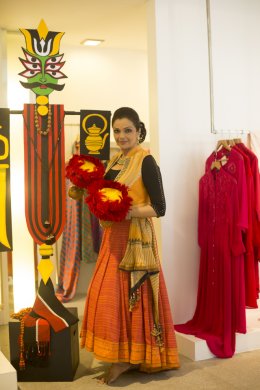 A Million Sitas at Collage I had predicted that dance and music would be seen in cafes, sari stores and art galleries in my writings over 7 years ago. And that is happening all around us in India. The openings of two new sari and jewellery boutiques in Chennai featured Carnatic musicians and Odissi dancers. I remember the big fuss created by purists when Ramli Ibrahim's Odissi dancers performed gracefully in the foyer of the India International Centre, New Delhi, 15 years ago around large URULI vessels filled with flowers and water. Today, the John Higgins' "curry concert" mantra has come to stay. Sumptuous high tea galas often herald private classical music concerts, creating a stampede for the free food and an exodus after an hour of the excellent music! Furniture and lifestyle stores are more interested in featuring performances on their grounds, but how can anything BUT entertainment eye candy be programmed? The surface, the environment, the ambience of chatteratti holding wine glasses and looking with glassy, jaded eyes - how does that alchemy work for a performer? How can there be a true building of 'rasa' if the "sthayi bhava" is WHERE'S THE PARTY TONIGHT? However, if we are trying to build new audiences for dance in India and eventually draw them into the mainstream theatres, then perhaps this is one of the ways forward. To curate and showcase short, interesting shows with bright talent and hopefully mentor them into a professional life in the arts. So, here's to the new architects of food, fashion, real estate and media. Look to the live arts and especially dance. It is the most potent and expressive of art forms!  After 16 years, this portal is being recognized for its presence in the life of Indian dancers worldwide. WE ARE BEING HONOURED. On November 15, Anitha Guha's academy is saluting this portal and its three member team for its steadfast dedication and successful presence on the world wide web. I accept this honour along with my two "dwarapalakas" - Lalitha and Sumathi! The Tridevis of narthaki.com! Congratulations all around! In spite of so much to worry about, dancers seem to find ways to persevere. We are the most resilient of artistes - ploughing through, like incessant drops of water on stone. Breaking through defenses and daunting odds. When I read about Parshwanath Upadhye's successful HARA in the words of Ramaa Bharadwaj, I am buoyed with hope for the younger generation of dance artistes who are finding ways to fund and create. Yes, most of them pay their bills by teaching - hundreds of students in person, via Skype and through foreign location workshops. How can we seniors encourage them to also think about creating a benchmark for excellence and artistic rigour without playing to the gallery and the adoring entourage? 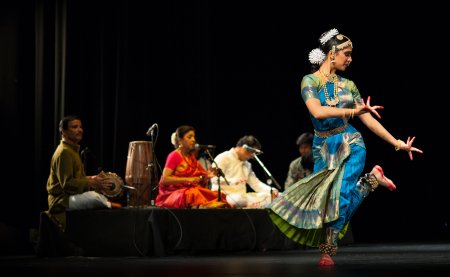 Ramya Harishankar, Tanmayi Vasisht ; Photo: Purpleganesh 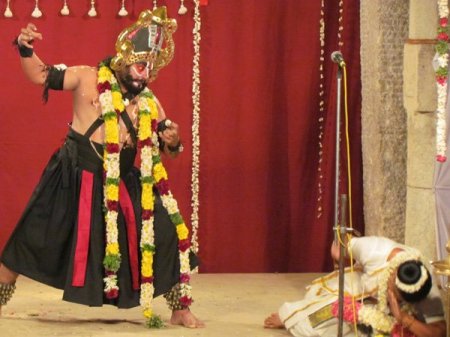
Kaisiki Natakam
The 17th annual revival performance of KAISIKI NATAKAM will be staged at my ancestral village of Tirukurungudi, Tirunelveli District, Tamilnadu. The moving story of a Rakshasa who seeks out a true devotee in the form of a low born villager makes for a compelling 5 hour re-enactment to a rapt audience of nearly 3000 at the Nambi Temple. Twenty years after I began the reconstruction project, the challenges of maintaining and motivating the actors remains an unsolved puzzle. And yes, caste continues to dominate many artistic decisions about who says what to whom! 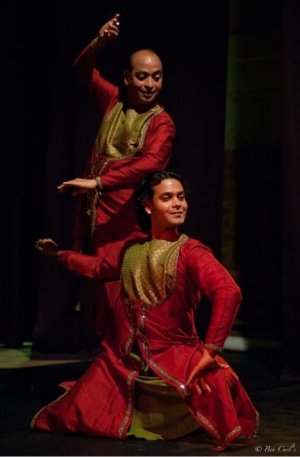 Pt. Arjun Mishra and his son Anuj Mishra 20, 30, 40, 50, 60, 70 and beyond, dance in India soldiers on. It was with great honesty and a large dollop of humour that Bharatanatyam diva Sudharani Raghupathy once told critic Leela Venkataraman, "We will not retire. You have to shoot us to make us stop!"???? New York critic Robert Johnson says it beautifully. "I will refuse to accept that dance is not important. I will fight every word and attitude against the power of dance. I will not give in or give up." And on that note, let me sign off - from the cool autumn of the Big Apple ablaze with the leaves turning orange and the city drenched in Halloween colours! Diwali is a few days away. Bring out your festive best. Burn away the old energies. Face the light and renew your vows to cherish life. A warm cyber hug to each of you who believe in this incredible life force we call DANCE! In gratitude, Dr Anita R Ratnam New York / Chennai / Mumbai / Tirukurungudi Twitter: @aratnam Facebook: Anita R Ratnam Instagram: @anitaratnam Blog: THE A LIST / anita-ratnam.blogspot.in Post your comments |